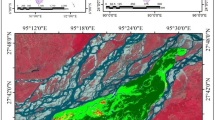Abstract
Rajaji National Park in U.P. is a protected area where large number of nomad population live within the park area. Their dependence on the forest for cattle rearing and firewood has caused degradation of the forests. Proximity to settlements outside the park further adds to the problems. In the present study, forest cover and river, bed changes have been attempted by using temporal aerospace data of the year 1960 and 1993. Subsequently, PAMAP GIS package has been used for the change detection analysis. The study indicates that the land cover changes are mainly due to biotic factors. Some of the important changes in forest cover are: (i) transformation of mixed forest to scrub forest in 67 ha (ii) the sal mixed and mixed sal forest categories have replaced sal forest in 262 ha (iii) significant increase in forest plantation i.e. 2075 ha in the year 1960 to 3793 ha in 1993 (iv) eighteen times increase in Chirpine area, it increased from 13 ha in 1960 to 230 ha in 1993. The land cover changes in 6663 ha (45%) out of 14962 ha of the study area. The consequential changes in the river beds due to the change in the forest cover was also analyzed. During this period river beds with boulders have increased by 87 ha. These river bed changes include lengthening and broadening of river and change in river course.
Similar content being viewed by others
References
Champion H C and Seth S K (1968). A revised survey of Forest types of India. Govt. Publications, New Delhi.
Hecht S B (1982). Agroforestry in the Amazon basin: Practice, theory and limits of a promising landuse. In: Amazonia, Agriculture and landuse (Eds. Hecht, S.B.). Research Proc. Int. Conf., CIAT Colombia, pp. 331–371.
Jain A, Shirish A Ravan, Das Mihir, Das K K, Porwal M C and Roy P S (1994). Remote sensing and Geographic information system - An approach for the assessment of Biotic interference in the forest ecosystem. Paper presented at the Asian Conf. on Remote Sensing held at Bangalore from Nov. 17–23, 1994.
Mc Neely J A (1992). The contribution of protected areas in sustaining society. Opening address to the IV World Cong., Caracas, Venezuala, Feb. 10–21. UNDP and UNEP.
Roy P S (1989). Vegetation analysis and study of its dynamics in Chandaka wildlife sanctuary (Orissa) using aerospace remote sensing. J. Indian Soc. Remote Sensing, 20(4):223–235.
Singh A (1986). Change detection in the tropical forest environment of North Eastern India using Landsat data. In: Remote Sensing and Tropical Land Management (Eds. Edens & J.J. Perry). John Wiley & Sons, pp. 237–253.
Singh I J (1986). Monitoring of forest cover type and landuse classes through remote sensing techniques (A case study in Ranikhet tehsil, U.P.). J. Indian Soc. Remote Sensing, 17(2):15–21.
Tomar M S and Maslekar A R (1974). Aerial photographs in Landuse and forest surveys. Jugal Kishor & Co., Dehradun, pp. 77–81.
Author information
Authors and Affiliations
About this article
Cite this article
Das, K.K., Ravan, S.A., Negi, S.K. et al. Forest cover monitoring using remote sensing and GIS — A case study in Dhaulkhand range of Rajaji National Park, Uttar pradesh. J Indian Soc Remote Sens 24, 33–42 (1996). https://doi.org/10.1007/BF03023890
Received:
Accepted:
Issue Date:
DOI: https://doi.org/10.1007/BF03023890




